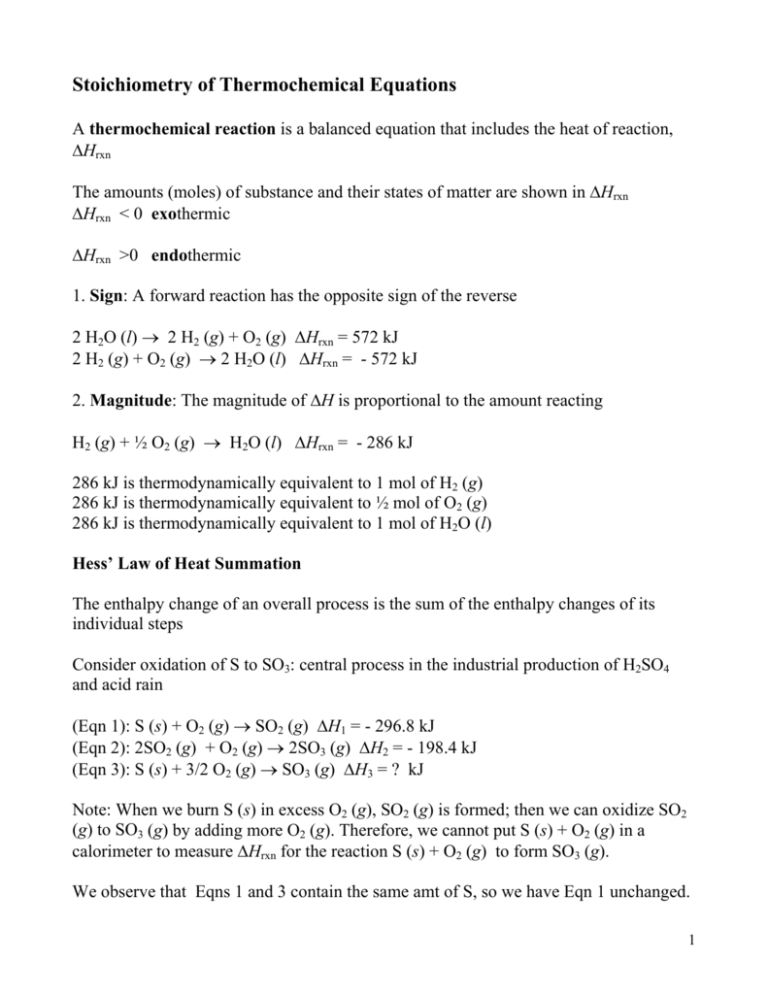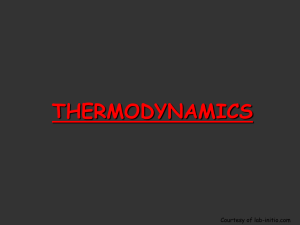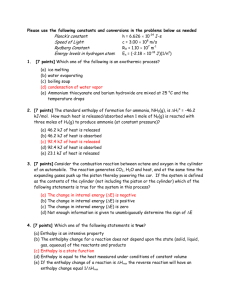Stoichiometry of Thermochemical Equations
advertisement

Stoichiometry of Thermochemical Equations A thermochemical reaction is a balanced equation that includes the heat of reaction, ∆Hrxn The amounts (moles) of substance and their states of matter are shown in ∆Hrxn ∆Hrxn < 0 exothermic ∆Hrxn >0 endothermic 1. Sign: A forward reaction has the opposite sign of the reverse 2 H2O (l) → 2 H2 (g) + O2 (g) ∆Hrxn = 572 kJ 2 H2 (g) + O2 (g) → 2 H2O (l) ∆Hrxn = - 572 kJ 2. Magnitude: The magnitude of ∆H is proportional to the amount reacting H2 (g) + ½ O2 (g) → H2O (l) ∆Hrxn = - 286 kJ 286 kJ is thermodynamically equivalent to 1 mol of H2 (g) 286 kJ is thermodynamically equivalent to ½ mol of O2 (g) 286 kJ is thermodynamically equivalent to 1 mol of H2O (l) Hess’ Law of Heat Summation The enthalpy change of an overall process is the sum of the enthalpy changes of its individual steps Consider oxidation of S to SO3: central process in the industrial production of H2SO4 and acid rain (Eqn 1): S (s) + O2 (g) → SO2 (g) ∆H1 = - 296.8 kJ (Eqn 2): 2SO2 (g) + O2 (g) → 2SO3 (g) ∆H2 = - 198.4 kJ (Eqn 3): S (s) + 3/2 O2 (g) → SO3 (g) ∆H3 = ? kJ Note: When we burn S (s) in excess O2 (g), SO2 (g) is formed; then we can oxidize SO2 (g) to SO3 (g) by adding more O2 (g). Therefore, we cannot put S (s) + O2 (g) in a calorimeter to measure ∆Hrxn for the reaction S (s) + O2 (g) to form SO3 (g). We observe that Eqns 1 and 3 contain the same amt of S, so we have Eqn 1 unchanged. 1 Eqn 2 has twice as much SO3 as we need for Eqn 3 so we multiply it by ½ S (s) + O2 (g) → SO2 (g) ∆H1 = - 296.8 kJ ½ ( 2SO2 (g) + O2 (g) → 2SO3 (g) ) ∆H2 = ½ (- 198.4) kJ _______________________________________________ Adding the manipulated equations S (s) + O2 (g) + SO2 (g) + ½ O2 (g) → SO2 (g) + SO3 (g) S (s) + 3/2 O2 (g) → SO3 (g) ∆H3 = ∆H1 + ½ ∆H2 = -296.8 + ½((-198.4) = - 396.0 kJ Example Two gaseous pollutants that form in auto exhaust are CO and NO. An environmental chemist is studying ways to convert them to less harmful gases through the following equation: CO (g) + NO (g) → CO2(g) + N2(g) ∆Hrxn = ? Given the following information, calculate the unknown ∆H Equation A: CO (g) + ½ O2 (g) → CO2 (g) ∆HA = -283.0 kJ Equation B: N2 (g) + O2 (g) → 2NO (g) ∆HB = 180.6 kJ Equations A and B have to be manipulated by reversal and/or multiplication by factors in order to sum to the first, or target, equation. Equation A: CO (g) + ½ O2 (g) → CO2 (g) ∆HA = -283.0 kJ Multiply Equation B by 1/2 and reverse it: NO (g) → ½ N2 (g) + ½ O2 (g) ∆HB = - 90.3 kJ ----------------------------------------------------------Adding the manipulated equations CO (g) + NO (g) → CO2 (g) + ½ N2 (g) ∆Hrxn = - 373.3 kJ Standard Enthalpies of formation ∆H of : is the enthalpy change for the formation of 1.0 of a compound directly from its component elements in its standards states. Standard State of an element of a compound: the most stable form of the substance in the physical state that exists at a presence of 1 bar and at a specified temperature. • For a gas the standard state is 1 bar with the gas behaving ideally, 1 atm = 1.013 bar • For a substance in aqueous solution the standard state is 1M 2 • For a pure substance (element or a compound) the standard state is usually the most stable of the substance at 1 bar and the temperature of interest (usually 25oC = 298 K) ∆H of for an element is zero (0) ∆Hrxn is measured with all reactants and products in their standard states. It is referred to o as the standard heat of reaction ∆H rxn Writing Formation Reactions Write balanced equations for the formation of 1 mol of the following compounds from their elements in their standard states and include ∆H of (a) Silver chloride, AgCl, a solid at standard conditions Ag (s) + ½ Cl2(g) → AgCl (s) ∆H of = -127.0 kJ (b) Calcium carbonate, CaCO3, a solid at standard conditions Ca (s) + C (graphite) + 3/2O2 (g) → CaCO3(s) ∆H of = -1206.9 kJ (c) Hydrogen cyanide, HCN, a gas at standard conditions ½ H2 (g) + C (graphite) + ½ N2 (g) → HCN (g) ∆H of = 135 kJ The general process for determining ∆Hrxn from ∆H of values. o ∆H rxn , can be considered as the sum of the enthalpy changes for the decomposition of reactants to their elements and the formation of products from their elements. The factors n and m are the amounts of the products and reactants and equal the coefficients in the balanced equation. The Greek letter ∑ is the symbol for the “sum of”. 3 Example 2 C3H5(NO3)3 (l) → 3N2(g) + ½ O2 (g) + 6 CO2 (g) + 5 H2O (g) ∆H orxn = 6 ∆H of [CO2 (g)] + 5 ∆H of [H2O (g)] + ½ ∆H of [O2 (g)] + 3 ∆H of [N2(g)] - 2 ∆H of [ C3H5(NO3)3 (l)] = 6(-393.5)+5(-241.8)-2(-364) = - 2842 kJ for 2 mol of C3H5(NO3)3 (l) Now, we seek the ∆H orxn for 10 g of C3H5(NO3)3 (l) mol of C3H5(NO3)3 (l) = 10 g / 227.1 g mol-1 = 0.0440 mol − 2842kJ = - 62. 6 kJ 2mol and ∆H orxn = (0.0440 mol) Most of the times reactions are exothermic EXOTHERMIC ⇔ PRODUCTS – FAVORED ENDOTHERMIC ⇔ REACTANTS – FAVORED Using Bond Enthalpies to Calculate ∆H orxn ∆H orxn is estimated by average bond enthalpies (BE) a) Break all the bonds in the reactants to generate free atoms in the gas phase – Atomization b) Make the product molecules from the free atoms o ∆H rxn = ∑ ∆H (bondsbroke n ) + ∑ ∆H (bondsforme d ) 4 Let us calculate the average BE of C – H ∆Ho (kJ) 438 CH4 (g) → CH3 (g) + H (g) 410 C2H6 (g) → C2H5 (g) + H (g) 429 CHF3 (g) → CF3 (g) + H (g) 380 CHCl3 (g) → CCl3 (g) + H (g) 377 CHBr3 (g) → CBr3 (g) + H (g) Average bond enthalpy: 413 kJ Values within 8% Example Calculate ∆H orxn for the chlorination of methane to form chloroform: CH4 (g) + 3Cl2 (g) → CHCl3 (g) + 3HCl (g) Write the Lewis structures for all reactants and products and calculate the number of bonds broken and formed. Cl H H C H H + 3 Broken Bonds broken Cl Cl H C Cl + 3 H Cl Cl Formed 5 4 x (C─H) = 4 mol (413 kJ/mol) = 1652 kJ 3 x (Cl─Cl) = 3 mol (243 kJ/mol) = 729 kJ Bonds formed 3 x (C─Cl) = 3 mol (-339 kJ/mol) = -1017 kJ 1 x (C─H) = 1 mol (-413 kJ/mol) = -413 kJ 3 x (H─Cl) = 3 mol (-427 kJ/mol) = -1281 kJ ∆H orxn kJ = Σ∆Ho bonds broken + Σ∆Ho bonds formed = 2381 kJ + (-2711 kJ) = - 330 Work w = (Force)(Displacement) w = F • d (dot product of two vectors) = scalar quantity (number) KE = 1 / 2mυ 2 w = ∆(KE) in the absence of frictional forces To raise a body of mass, m from height h1 to h2 a force upward is needed sufficient enough to overcome the downward force of gravity ( = mg) w = mg (h2 - h1) = mg ∆h The work leads to a change in the Potential Energy (PE = mgh) ∴ There is a connection between the performance of mechanical work and a change in energy force Pr essure = unitarea Pressure – Volume work (P – V work) System expands or compressed against an outside (external) pressure Heating the gas inside the cylinder causes it to expand pushing the piston against the pressure exerted by the gas outside, Pext F1 = P1A (force exerted by the piston on the gas) If P1= Pext then the piston experiences equal forces on both sides and it doesn’t move. If Pext > P1 gas is compressed and the piston moves inward. If Pext < P1 gas is expanded and the piston moves outward. w = - Fext (h2 – h1) = - Fext ∆h = - PextA(∆h)= - Pext∆V 6 If ∆V = + w = - system performs work on the surroundings If ∆V = - w = + surroundings perform work on the system If ∆V = 0 no P – V work is done If Pext = 0 no P – V work is done Units Pa(scal) = N m-2 ∆V is in m3 w is in Joules If P is in atm and ∆V is in liters then w is in L atm. And 1 L atm = 101.325 J The First Law of Thermodynamics Internal Energy (E): sum of Potential Energy + Kinetic Energy of atoms, molecules or ions Potential Energy: attractive and repulsive forces between nuclei and e − Kinetic Energy: motion of atoms, molecules or ions Absolute E is too difficult to determine!!!!!! But we measure ∆E ∆E = q + w ← work transferred from and to system change in energy content ↵ ↑ heat transferred to and from the system For any closed system the heat added to the system is removed from the surroundings q sys = - q surroundings w sys = - w surroundings ∆E sys = - ∆E surroundings ∆E sys + ∆E surroundings = 0 ∆E universe = ∆E sys + ∆E surroundings Internal energy and enthalpy values do not depend on the path chosen to go from initial to final states: state functions ∆E = q + w ← does depend on path does NOT depend on path ↵ ↑ does depend on path 7 Now we define H = E + PV ∆H =∆E + ∆(PV) ∆H =∆E + P∆V but w = - P∆V ∆E=qP + w ∆E=qP - P∆V ∆H = qP - P∆V + P∆V = qP The only work allowed is from a volume change. ∆H rxn ≈ ∆E rxn in 1. Reactions that do not involve gases 2. Reactions in which the number of moles of gas does not change 3. Reactions in which the number of moles of gas does change but q is >>> P∆V Consider C (graphite) + ½ O2 (g) → CO (g) ∆H rxn = - 110.5 kJ mol-1 We would like to calculate ∆E rxn if the rxn occurs at P = 1 atm and T = 298 K We saw that ∆H =∆E + ∆(PV) and ∆E = ∆H - ∆(PV) Eproducts – Ereactants = (Hproducts – Hreactants) – (PproductsVproducts – PreactantsVreactants) We make two assumptions: a) ignore the volume of C (graphite), a solid much smaller than the volume of O2 (g) b) O2 (g) and CO (g) behave ideally, and therefore, ∆(PV) ≈ ∆(nRT) = RT∆(ng) ∆(ng) = ng, products - ng, reactants = 1 – ½ = ½ ∆(PV) = RT∆(ng) = (8.314 JK-1mol-1)(298.15 K)( ½) = 1.24 x 103 J mol-1 ∆Erxn = ∆Hrxn - ∆(PV) = - 110.5 kJ mol-1 – 1.24 kJ mol-1 = - 111.7 kJ mol-1 8 A system transferring energy as heat only A system losing energy as work only 9 Example When gasoline burns in a car engine, the heat released causes the products CO2 and H2O to expand which push the pistons outward. Excess heat is removed by car’s cooling system. If the expanding gases do 451 J of work on the pistons and the system loses 325 J to the surroundings as heat, calculate ∆E. q = - 325 J w = - 451 J ∆E = q + w = - 325 J + (- 451 J) = - 776 J = - 0. 776 kJ -0.776 kJ x (1 kcal / 4.184 kJ) = -0.185 kcal 10








